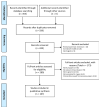A Systematic Review of Genotype-Phenotype Correlation across Cohorts Having Causal Mutations of Different Genes in ALS
- PMID: 32610599
- PMCID: PMC7564886
- DOI: 10.3390/jpm10030058
A Systematic Review of Genotype-Phenotype Correlation across Cohorts Having Causal Mutations of Different Genes in ALS
Abstract
Amyotrophic lateral sclerosis is a rare and fatal neurodegenerative disease characterised by progressive deterioration of upper and lower motor neurons that eventually culminates in severe muscle atrophy, respiratory failure and death. There is a concerning lack of understanding regarding the mechanisms that lead to the onset of ALS and as a result there are no reliable biomarkers that aid in the early detection of the disease nor is there an effective treatment. This review first considers the clinical phenotypes associated with ALS, and discusses the broad categorisation of ALS and ALS-mimic diseases into upper and lower motor neuron diseases, before focusing on the genetic aetiology of ALS and considering the potential relationship of mutations of different genes to variations in phenotype. For this purpose, a systematic review is conducted collating data from 107 original published clinical studies on monogenic forms of the disease, surveying the age and site of onset, disease duration and motor neuron involvement. The collected data highlight the complexity of the disease's genotype-phenotype relationship, and thus the need for a nuanced approach to the development of clinical assays and therapeutics.
Keywords: ALS; ALS genes; ALS variants; MND; genotype–phenotype.
Conflict of interest statement
The authors declare no conflict of interest.
Figures




References
-
- Logroscino G., Piccininni M., Marin B., Nichols E., Abd-Allah F., Abdelalim A., Alahdab F., Asgedom S.W., Awasthi A., Chaiah Y., et al. Global, regional, and national burden of motor neuron diseases 1990–2016: A systematic analysis for the Global Burden of Disease Study 2016. Lancet Neurol. 2018;17:1083–1097. doi: 10.1016/S1474-4422(18)30404-6. - DOI - PMC - PubMed
-
- Talbott E.O., Malek A.M., Lacomis D. Handbook of Clinical Neurology. Volume 138. Elsevier; Amsterdam, The Netherlands: 2016. The epidemiology of amyotrophic lateral sclerosis; pp. 225–238. - PubMed
Publication types
Grants and funding
LinkOut - more resources
Full Text Sources
Miscellaneous

